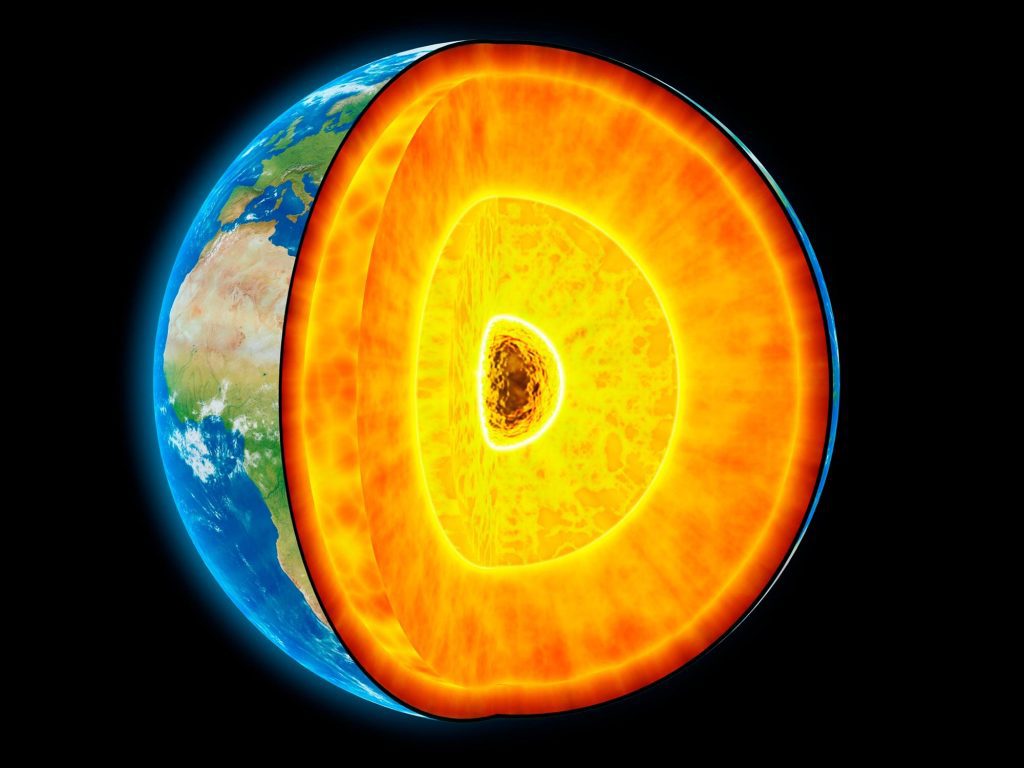
A variação de um segundo no tempo de viagem de um grupo de ondas sísmicas nos dá uma visão importante e sem precedentes do que está acontecendo nas profundezas da Terra.
A teoria apóia nossa compreensão da convecção no núcleo externo da Terra e sua função no controle do campo magnético do planeta. Os cientistas não observaram diretamente os fluxos convectivos ou como eles mudam. O geólogo Ying Zhou da Virginia Tech fornece evidências pela primeira vez.
Um grande terremoto abalou a região das Ilhas Kermadec no Pacífico Sul em maio de 1997. Pouco mais de 20 anos depois, em setembro de 2018, um segundo grande terremoto atingiu o mesmo local, com suas ondas de energia sísmica emanadas da mesma região.
Embora duas décadas de sismicidade separassem os terremotos, porque eles ocorreram na mesma região, seria esperado que eles enviassem ondas sísmicas através das camadas da Terra na mesma velocidade, disse Ying Zhou, geólogo do Departamento de Ciências da Terra da Virginia Tech. Ciências.

O caminho azul mostra uma onda sísmica penetrando no núcleo movendo-se através de uma região no núcleo externo, onde a velocidade sísmica aumentou devido à transmissão de um fluxo de baixa intensidade para a região. Crédito: Ying Zhou da Virginia Tech
No entanto, em dados registrados em quatro das mais de 150 estações da rede sísmica global que registram vibrações sísmicas em tempo real, Zhou encontrou anomalias surpreendentes entre os eventos gêmeos. Durante o terremoto de 2018, um grupo de ondas sísmicas chamadas ondas SKS se moveram cerca de um segundo mais rápido do que suas contrapartes de 1997.
De acordo com Zhou, cujos resultados foram recentemente publicados em
Blue lines are seismic rays in the outer core, where core-penetrating seismic waves moved through that region faster in 2018 than in 1997. Credit: Image courtesy of Ying Zhou
Scientists also have only been able to speculate about the source of gradual changes in strength and direction of the magnetic field that have been observed, which likely involves changing flows in the outer core.
“If you look at the north geomagnetic pole, it’s currently moving at a speed of about 50 kilometers (31 miles) per year,” Zhou said. “It’s moving away from Canada and toward Siberia. The magnetic field is not the same every day. It’s changing. Since it’s changing, we also speculate that convection in the outer core is changing with time, but there’s no direct evidence. We’ve never seen it.”
Zhou set out to find that evidence. The changes happening in the outer core aren’t dramatic, she said, but they’re worth confirming and fundamentally understanding. In seismic waves and their changes in speed on a decade time scale, Zhou saw a means for “direct sampling” of the outer core. That’s because the SKS waves she studied pass right through it.
“SKS” represents three phases of the wave: First it goes through the mantle as an S wave, or shear wave; then into the outer core as a compressional wave; then back out through the mantle as an S wave. How fast these waves travel depend in part on the density of the outer core that’s in their path. If the density is lower in a region of the outer core as the wave penetrates it, the wave will travel faster, just as the anomalous SKS waves did in 2018.
“Something has changed along the path of that wave, so it can go faster now,” Zhou said.
To Zhou, the difference in wave speed points to low-density regions forming in the outer core in the 20 years since the 1997 earthquake. That higher SKS wave speed during the 2018 earthquake can be attributed to the release of light elements such as hydrogen, carbon, and oxygen in the outer core during convection that takes place as the Earth cools, she said.
“The material that was there 20 years ago is no longer there,” Zhou said. “This is new material, and it’s lighter. These light elements will move upward and change the density in the region where they’re located.”
To Zhou, it’s evidence that movement really is happening in the core, and it’s changing over time, as scientists have theorized. “We’re able to see it now,” she said. “If we’re able to see it from seismic waves, in the future, we could set up seismic stations and monitor that flow.”
What’s next
That’s Zhou’s next effort. Using a method of wave measurement known as interferometry, her team plans to analyze continuous seismic recordings from two seismic stations, one of which will serve as a “virtual” earthquake source, she said.
“We can use earthquakes, but the limitation of relying on earthquake data is that we can’t really control the locations of the earthquakes,” Zhou said. “But we can control the locations of seismic stations. We can put the stations anywhere we want them to be, with the wave path from one station to the other station going through the outer core. If we monitor that over time, then we can see how core-penetrating seismic waves between those two stations change. With that, we will be better able to see the movement of fluid in the outer core with time.”
Reference: “Transient variation in seismic wave speed points to fast fluid movement in the Earth’s outer core” by Ying Zhou, 25 April 2022, Communications Earth & Environment.
DOI: 10.1038/s43247-022-00432-7

“Maven da Web. Geek de cerveja irritantemente humilde. Fanático por bacon. Criador típico. Especialista em música.”







More Stories
Inspetor Geral da NASA emite relatório contundente sobre atrasos no projeto de lançamento da espaçonave SLS
Como os buracos negros ficaram tão grandes e rápidos? A resposta está no escuro
Uma estudante da Universidade da Carolina do Norte se tornará a mulher mais jovem a cruzar as fronteiras do espaço a bordo da Blue Origin